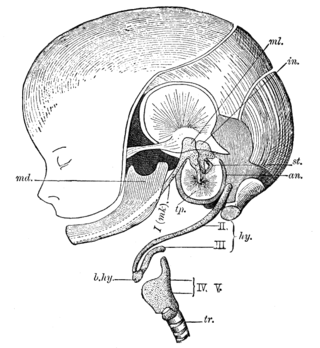into communication with the internal organ of hearing would be homologous throughout the series. He believed, therefore, that the entire chain of ossicula auditus in the mammal is equal to the columella of the reptile, since their relations are the same to the tympanum on the one hand and to

Fig. 15.—Head of a Human embryo of the fourth month. Dissected to show the auditory ossicles, tympanic ring, and Meckel's cartilage, with the hyoid and thyroid apparatus. All these parts are delineated on a larger scale than the rest of the skull. an, Tympanic ring; b.hy, basihyal element; hy, so-called hyoid bone; in, incus; md, bony mandible; ml, malleus; st, stapes; tp, tympanum; tr, trachea; I. (mk), first skeletal (mandibular) arch (Meckel's cartilage); II. second skeletal (hyoid) arch; III. third (first branchial) arch; IV. V. fourth and fifth arches (thyroid cartilage). (From Wiedersheim's Structure of Man.)
the foramen ovale on the other; and that the lower jaw articulates in the same way in both. It follows, therefore, that the glenoid part of the squamosal must be the quadrate which has become ankylosed with it after the fashion of concentration in the mammalian skull that has already been referred to. The fact that occasionally the glenoid part of the squamosal is a separate bone[1] appeared to confirm this way of looking at the
- ↑ Cf. the Armadillo Peltephilus, p. 186.
